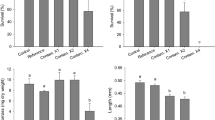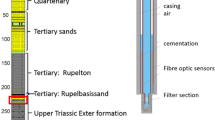Abstract
Drilling for oil on the North Slope of Alaska results in the release of large volumes of used drilling fluids into arctic wetlands. These releases, usually come from regulated discharges or seepage from reserve pits constructed to hold used drilling fluids. A study of five drill sites and their reserve pits showed an increase in common and trace elements and organic hydrocarbons in ponds near-to and distant from reserve pits. Ions elevated in water were Ba, Cl, Cr, K, SO4 and Zn. Concentrations of Cu, Cr, Fe, Pb, and Si in sediments were higher in near and distant ponds than in control ponds. The predominant organics in drill site waters and sediments consisted of aromatic and paraffinic hydrocarbons characteristic of petroleum or a refined product of petroleum. In 96-hr exposures in the field, toxicity toDaphnia Middendorffiana was observed in water from all reserve pits, and from two of five near ponds, but not from distant ponds. In laboratory tests withDaphnia magna, growth and reproduction were reduced in dilutions of 2.5% drilling fluid (2.5 drilling fluid: 97.5 dilution water) from one reserve pit, and 25% drilling fluid from a second. Growth and reproduction were not affected at these dilutions of fluid from the other three reserve pits. Additional regulations—such as an upper limit on aromatic hydrocarbon content and toxicity to sensitive organisms —are needed to improve safety for aquatic organisms in habitats receiving used drilling fluids.
Similar content being viewed by others
References
ADEC (Alaska Department of Environmental Conservation) (1984) Survey of drilling mud use and disposal. Alaska Water Quality Management Planning Program. Anchorage, AK, 32 pp
APHA (American Public Health Association, American Water Works Association, Water Pollution Control Federation) (1980) Standard methods for the examination of water and wastewater (15th ed), American Public Health Association. Washington, DC, 1134pp
API (American Petroleum Institute) (1969) Principles of drilling fluid control (12th ed). Petroleum Extension Service, University of Texas, Austin, TX, 215 pp
Anderson JW, Riley RG, Bean RM (1978) Recruitment of benthic animals as a function of petroleum hydrocarbon concentrations in the sediment. J Fish Res Board Can 35:776–790
Barsdate RJ, Miller MC, Alexander V, Vestal JR, Hobbie JE (1980) Oil spill effects. In; Hobbie JE (ed) Limnology of tundra ponds, Barrow, Alaska. Dowden, Hutchinson and Ross, Inc, Stroudsburg, PA, 514 pp
Blumer M, Blokker PC, Codwell EB, Duckworth DF (1972) Petroleum. In: Goldberb ED (ed) A guide to marine pollution. Gordon and Breach, London, pp 330–356
Buikema AL, Jr, Geiger JG, Lee DR 1980Daphnia toxicity tests. In: Buikema AL and Cairns J (eds) American Society for Testing and Materials, Special Technical Publication 715. Philadelphia, PA pp 48–69
Caragay AB, Leven PL (1979) Evaluation of Protocols for Pesticides and PCBs in Raw Wastewater. U.S. Environmental Protection Agency Report, EPA-600/2-79-1, Washington, DC, 66 pp
Carr RS, McCulloch WL, Neff JM (1982) Bioavailability of chromium from a used chrome lignosulphonate drilling mud to five species of marine invertebrates. Mar Environ Res 6:189–203
Clark RL Jr, Finley JS (1973) Techniques for analysis of paraffin hydrocarbons and for interpretation of data to assess oil spill effects in aquatic organisms. In: Proceedings of the 1973 Joint Conference on Prevention and Control of Oil Spills. API/EPA/USGS, Washington, DC, pp 161–172
Clark RC Jr, MacLeod WD Jr (1977) Inputs, transport mechanisms, and observed concentrations of petroleum in the marine environment. In: Malins DD (ed) Effect of petroleum on arctic and subarctic marine environments and organisms. Academic Press, Inc., New York, NY, 500 pp
Collins AG (1975) Possible contamination of groundwaters by oil and gas well drilling fluids. U.S. Energy Research and Development Administration Report No. Conf-7505133-1, Bartlesville Energy Research Center, Bartlesville, OK, 37 PP
Conklin PJ, Drysdale D, Doughtie DG, Rao KR, Kakareka JF, Gilbert TR, Shokes RF (1983) Comparative toxicity of drilling muds: Role of chromium and petroleum hydrocarbons. Mar Environ Res 10:105–125
Conklin PJ, Rao KR (1984) Comparative toxicity of offshore and oil-added drilling muds to larvae of the grass shrimpPalaemonetes intermedius. Arch Environ Contam Toxicol 13:685–690
Cowgill UM, Emmel HW, Hopkins DL, Appelgath SL, Tadahasni IT (1986) The influence of water on reproductive success and chemical composition of laboratory reared populations ofDaphnia magna. Water Res 20:317–323
Dames & Moore (1978) Drilling Fluid Dispersion and Biological Effects Study for the Lower Cook Inlet C.O.S.T. Well. Submitted to Atlantic Richfield Company, Dallas, Texas. Dames & Moore, Anchorage, AK, 309 pp
Deeley GM, Canter LW (1986) Distribution of heavy metals in waste drilling fluids under conditions of changing pH. J Environ Qual 15:108–112
Duke TW, Parrish PR (1984) Results of the Drilling Fluids Research Program Sponsored by the Gulf Breeze Environmental Research Laboratory, 1976–1983, and Their Application to Hazard Assessment. U.S. Environmental Protection Agency Report 600/4-84-055, Environmental Research Laboratory USEPA, Gulf Breeze, FL, 87 pp
Elnabarawy MT, Welter N, Robideau R (1986) Relative sensitivity of three daphnid species to selected organic and inorganic chemicals. Environ Toxicol Chem 5:393–398
ERL (Edgerton Research Laboratory, New England Aquarium). 1984. A Survey of the toxicology and chemical composition of used drilling muds. U.S. Environmental Protection Agency Report 600/3-84-071, Environmental Research Laboratory, USEPA, Gulf Breeze, FL, 109 pp
Farrington JW, Teal JM, Quinn JG, Wade T, Burns K (1973) Intercalibration of analyses of recently biosynthesized hydrocarbons and petroleum hydrocarbons in marine lipids. Bull Environ Contam Toxicol 10:129–136
Heller SR, Milne GWA (1978) EPA/NIH Mass spectral data base, Vols 1 and 2. U.S. Dept. of Commerce, U.S. Government Printing Office, Washington, DC
Hiatt MH, Jones TL (1985) Identification and quantification of diesel fuel components derived from off-shore drilling operation discharges. J High Resolution Chromatogr and Chromatogr Comm 8:4–7
Malueg KW, Schuytema GS, Gakstatter JH, Krawcsk DF (1984) Toxicity of sediments from three metal contaminated areas. Environ Toxicol Chem 3:279–291
Murphy EC, Kehew AE (1984) The effect of oil and gas well drilling fluids on shallow groundwater in Western North Dakota. North Dakota Geological Survey Rep. No. 82, Fargo, ND, 120 pp
National Research Council (1975) Petroleum in the Marine Environment. National Academy of Sciences. Washington, DC, 107 pp
— (1983) Drilling discharges in the marine environment. Panel on Assessment of Fates and Effects of Drilling Fluids and Cuttings in the Marine Environment. National Academy Press, Washington, DC, 192 pp
Neff JM (1982) Fate and biological effects on oil well drilling fluids in the marine environment: A literature review. U.S. Environmental Protection Agency Report 600/3-82-064, Environmental Research Laboratory, USEPA, Gulf Breeze, FL, 168 pp
Nikunen E, Miettinen V (1985)Daphnia magna as an indicator of the acute toxicity of waste waters. Bull Environ Contam and Toxicol 35:368–374
Norton DW, Alies Iw, Curatals JA (1975) Ecological relationships of the inland tundras avifauna near Prudhoe Bay, Alaska. In: Brown J (ed.). Ecological Investigations of the Tundra Biome in the Prudhoe Bay Region, Alaska. Spec. Report No. 2, Biol. Papers, University of Alaska. Fairbanks, AK, 124–133
Snedecor GW, Cochran WG (1980) Statistical methods, 7th Ed. Iowa State University Press. Ames, IA, 507 pp
Tagatz ME, Plaia R, Deans H (1985) Responses of macrobenthos colonizing estuarine sediments contaminated with drilling mud-containing diesel oil. Bull Environ Contam and Toxicol 35:112–120
Trucco RG, Engelhard FR, Stacey B (1983) Toxicity, accumulation, and clearance of aromatic hydrocarbons inDaphnia pulex. Environ Pollut 31:191–202
USEPA (United States Environmental Protection Agency) (1973) Water quality criteria. 1972. U.S. Environmental Protection Agency Report R3/73-033, Washington, DC, 594 pp
— (1976) Qualtiy criteria for water. U.S. Environmental Protection Agency, Washington, DC, 256 pp
Vanderploeg HA, Parzyck DC, Wilcox WH, Kerdher JR, Kaye SV (1975) Bioaccumulation factors for radionuclides in freshwater biota. Environmental Sciences Division Publication No. 783, Oak Ridge National Laboratory, Oak Ridge, TN, 216 pp
West RL, Snyder-Conn, E (1987) Effects of Prudhoe Bay reserve pit fluids on water quality and macroinvertebrates of tundra ponds. U.S. Fish Wildl Serv Biol Rep 87(7), Washington, DC, 48 pp
Woodward DF, Riley FG (1983) Petroleum hydrocarbon concentrations in a salmonid stream contaminated by oil field discharge water and effects of macrobenthos. Arch Environ Contam Toxicoi 12:327–334
Woodward DF, Riley FG, Henry MG, Meyer JS, Gariand TR (1985) Leaching of retorted oil shale: Assessing the toxicity to Colorado squawfish, fathead minnows, and two foodchain organisms. Trans Amer Fish Soc 114:887–894
Wright TR (1978) Guide to drilling, workover, and completion fluids. World Oil 6:53–96
Author information
Authors and Affiliations
Rights and permissions
About this article
Cite this article
Woodward, D.F., Snyder-Conn, E., Riley, R.G. et al. Drilling fluids and the arctic tundra of Alaska: Assessing contamination of wetlands habitat and the toxicity to aquatic invertebrates and fish. Arch. Environ. Contam. Toxicol. 17, 683–697 (1988). https://doi.org/10.1007/BF01055838
Received:
Revised:
Issue Date:
DOI: https://doi.org/10.1007/BF01055838




